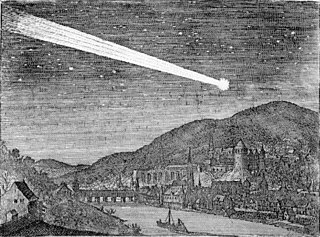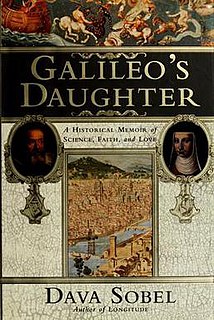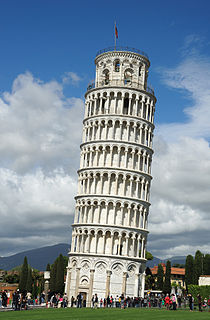 W
WGalileo di Vincenzo Bonaiuti de' Galilei was an Italian astronomer, physicist and engineer, sometimes described as a polymath, from Pisa. Galileo has been called the "father of observational astronomy", the "father of modern physics", the "father of the scientific method", and the "father of modern science".
 W
W55 Cancri b, occasionally designated 55 Cancri Ab, also named Galileo, is an exoplanet orbiting the Sun-like star 55 Cancri A every 14.65 days. It is the second planet in order of distance from its star, and is an example of a hot Jupiter, or possibly rather "warm Jupiter".
 W
WPisa International Airport, also named Galileo Galilei Airport is an airport located in Pisa, Italy. It is the main airport in Tuscany and the 10th in Italy in terms of passengers. It is named after Galileo Galilei, the famous scientist and native of Pisa. The airport was first developed for the military in the 1930s and 1940s. The airport was used by 5,233,118 passengers in 2017. It serves as a focus city of Ryanair.
 W
W"And yet it moves" or "Albeit it does move" is a phrase attributed to the Italian mathematician, physicist and philosopher Galileo Galilei (1564–1642) in 1633 after being forced to recant his claims that the Earth moves around the Sun, rather than the converse. In this context, the implication of the phrase is: despite his recantation, the Church's proclamations to the contrary, or any other conviction or doctrine of men, the Earth does, in fact, move.
 W
WNiccolò Arrighetti was Italian intellectual, pupil and associate of Galileo Galilei.
 W
WVirginio Cesarini was an Italian poet and intellectual.
 W
WScipione Chiaramonti was an Italian philosopher and noted opponent of Galileo.
 W
WGiovanni Ciampoli or Giovanni Battista Ciampoli was a priest, poet and humanist. He was closely associated with Galileo Galilei and his disputes with the Catholic Church.
 W
WLodovico delle Colombe was an Italian Aristotelian scholar, famous for his battles with Galileo Galilei in a series of controversies in physics and astronomy.
 W
WGiorgio Coresio (1570-1659?) from the Greek island of Chios was a lecturer in Greek at the University of Pisa from 1609-1615. He was obliged to resign his chair either because it was discovered that he secretly professed the Greek Orthodox faith, or because of his mental illness - he is said to have had daily visions of saints.
 W
WThe Discourse on Comets was a pamphlet published in 1619 with Mario Guiducci as the named author, though in reality it was mostly the work of Galileo Galilei. In it Galileo conjectured that comets were not physical bodies but atmospheric effects like the aurora borealis.
 W
WGalileo was an American robotic space probe that studied the planet Jupiter and its moons, as well as several other Solar System bodies. Named after the Italian astronomer Galileo Galilei, it consisted of an orbiter and an entry probe. It was delivered into Earth orbit on October 18, 1989 by Space Shuttle Atlantis. Galileo arrived at Jupiter on December 7, 1995, after gravitational assist flybys of Venus and Earth, and became the first spacecraft to orbit Jupiter. It launched the first probe into Jupiter, directly measuring its atmosphere. Despite suffering major antenna problems, Galileo achieved the first asteroid flyby, of 951 Gaspra, and discovered the first asteroid moon, Dactyl, around 243 Ida. In 1994, Galileo observed Comet Shoemaker–Levy 9's collision with Jupiter.
 W
WThe Galileo affair began around 1610 and culminated with the trial and condemnation of Galileo Galilei by the Roman Catholic Inquisition in 1633. Galileo was prosecuted for his support of heliocentrism, the astronomical model in which the Earth and planets revolve around the Sun at the centre of the Solar System.
 W
WGalileo's Daughter: A Historical Memoir of Science, Faith, and Love is a book by Dava Sobel published in 1999. It is based on the surviving letters of Galileo Galilei's daughter, the nun Suor Maria Celeste, and explores the relationship between Galileo and his daughter. It was nominated for the 2000 Pulitzer Prize for Biography or Autobiography.
 W
WGalileo's escapement is a design for a clock escapement, invented around 1637 by Italian scientist Galileo Galilei. It was the earliest design of a pendulum clock. Since he was by then blind, Galileo described the device to his son, who drew a sketch of it. The son began construction of a prototype, but both he and Galileo died before it was completed.
 W
WBetween 1589 and 1592, the Italian scientist Galileo Galilei is said to have dropped two spheres of different masses from the Leaning Tower of Pisa to demonstrate that their time of descent was independent of their mass, according to a biography by Galileo's pupil Vincenzo Viviani, composed in 1654 and published in 1717.
 W
WLetters on Sunspots was a pamphlet written by Galileo Galilei in 1612 and published in Rome by the Accademia dei Lincei in 1613. In it, Galileo outlined his recent observation of dark spots on the face of the Sun. His claims were significant in undermining the traditional Aristotelian view that the Sun was both unflawed and unmoving.